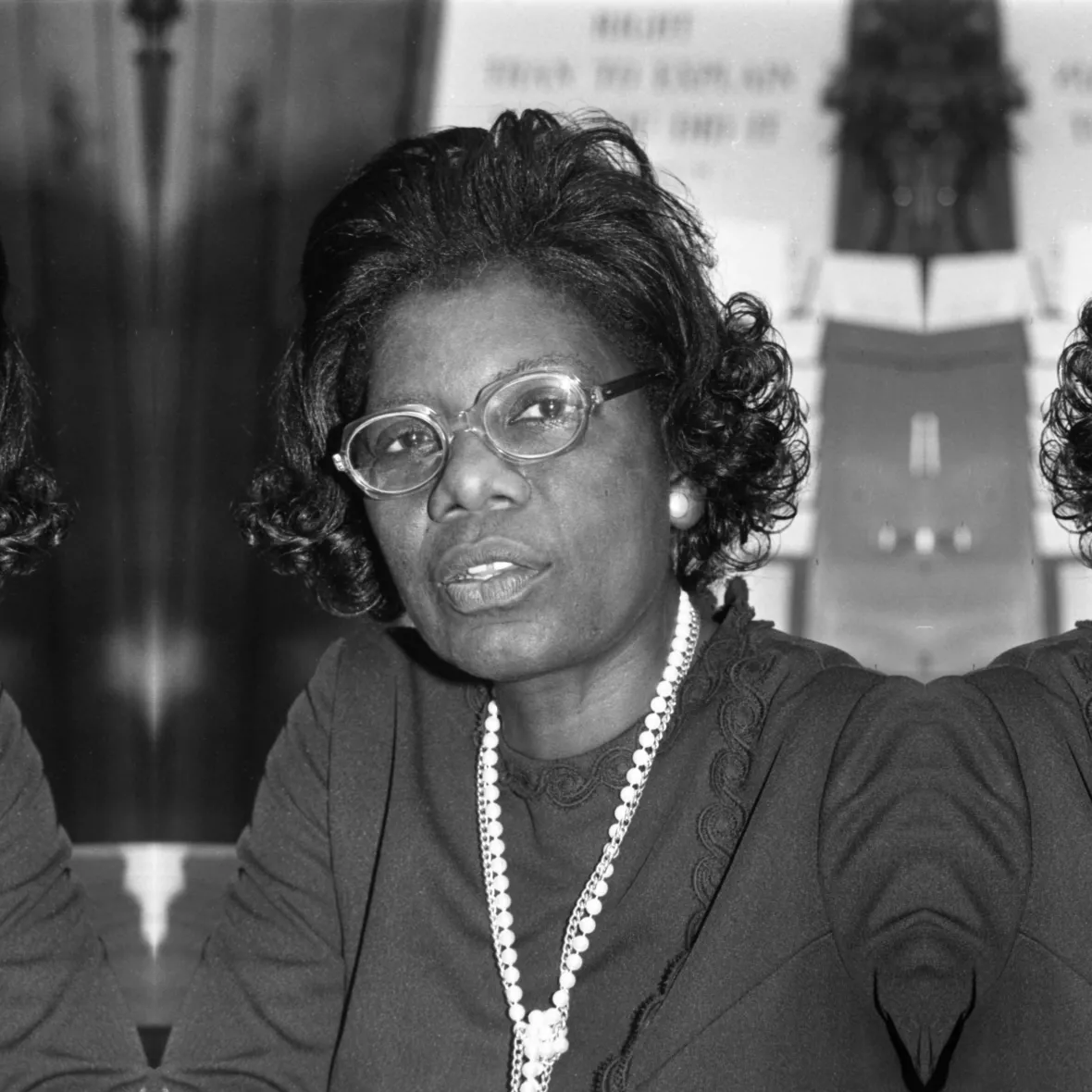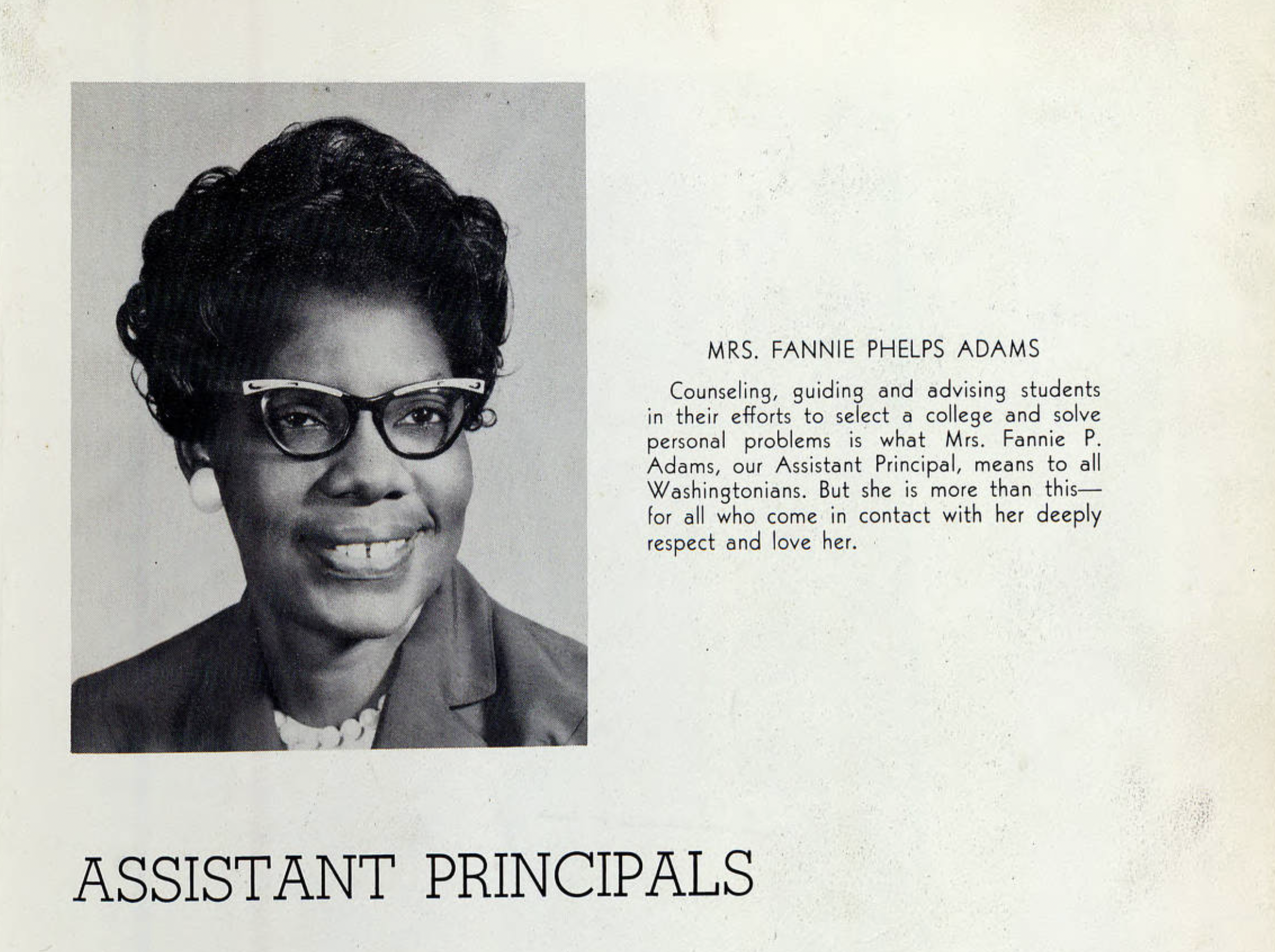 View All Honorees
View All Honorees
Columbia City of Women Honoree
Fannie Phelps Adams
Fannie Phelps Adams, 1977. Image courtesy The State Newspaper Photograph Archive, Richland Library
…We didn’t know we were poor. You can’t explain that, but our parents didn’t stress that we were poor. We knew we were headed upward. There is not a single profession that did not come off The Hill.
- The State, July 15, 1994
[The University of South Carolina had] a laboratory in their lap, but they were interested in the land instead of the people.
– Fannie Phelps Adams, The State, February 28, 1974
While the City of Columbia and the University of South Carolina (UofSC) first segregated and then worked to uproot and displace Black communities during the 20th century, Fannie Phelps Adams held fast to her roots in Wheeler Hill and taught students at nearby Booker T. Washington High School to blossom.
Fannie Phelps Adams spent all but the first 17 days of her life as a resident of Catawba (Tobacco) Street in the historically Black Wheeler Hill neighborhood. Born in 1917 to James and Mary Lou Wilbur Phelps at her maternal grandmothers’ home in Laurens, Phelps was the eighth of ten children who came of age in Jim Crow Columbia. Raised by a widowed mother beginning at the age of four, Phelps became determined to complete her college education at an accelerated pace to get her mother, a laundress, “out of the washtub.”
After graduating from Booker T. Washington High School in 1934 and Allen University in 1938, she secured employment as a teacher at Booker T. Washington Heights Elementary (present-day Watkins-Nance Elementary), ensuring her mother’s last ten years were spent in retirement. In 1943, she was hired as a social studies and English teacher at Booker T. Washington High School, which remained the only Black secondary school in Columbia. Phelps married her college sweetheart, David King Adams, in 1947, and the couple purchased 1620 Catawba Avenue, just down the street from her childhood home.
Our philosophy was such that it was based on the total development of the whole child. Every child could achieve.
– Fannie Phelps Adams, The State, July 7, 1991
Our stress to children then was you’ve got to be “better than” if you plan to be successful.
– Fannie Phelps Adams, The State, October 6, 2009
Adams received her master’s degree from South Carolina State University in 1953; by then she had been promoted to guidance counselor. Three years later she became the school’s assistant principal and held both positions until the school’s closure in 1974.

Image courtesy Yearbooks of Columbia Area Schools Collection, Richland Library
In “Guidance During Segregation,” Fannie Phelps Adams describes her experiences as a guidance counselor at both Booker T. Washington and A.C. Flora.
UofSC Museum of Education, October 1, 2008
Booker's closure shocked almost everyone affiliated with the school. During its final week, a State reporter observed that “as assistant principal—and virtually mother confessor to Booker T. students—Mrs. Adams bore much of the brunt of anger and frustration from every direction.”
Although Adams would finish out her career at A.C. Flora High School to local, state, and national accolades, she could not stop the outside forces that soon tore apart “the Hill.” What was once, in the 1940s, a bustling Black neighborhood replete with 42 businesses and 210 families, had by 1974 been almost entirely acquired through UofSC’s Carolina Research and Development Foundation (CR&D), an entity created to purchase land that the City of Columbia had deemed “blighted” and targeted for urban renewal.
The historically white university began acquiring land in Wheeler Hill in 1960, even as the institution itself remained segregated and off-limits to Booker T. graduates; in the years following desegregation, UofSC began systematically subsuming and dismantling their entire neighborhood. According to university official Hal Bruton, the university had three objectives for Wheeler Hill: to “‘eliminate an extremely blighted, slum area,’ of about sixteen blocks in the ‘heart of the City,’ offer residents an opportunity to move into better housing, and provide land for university expansion.” The university ultimately achieved the first and third of these goals; as one resident explained, urban renewal really meant “black removal.”
.jpg)
Although Phelps and another homeowner, Bernice Martin, formed the Wheeler Hill Community Association to attempt to negotiate with UofSC, CR&D, and city officials for affordable housing for former renters removed following the sale of their homes, no such housing was built. By the 1990s, just a few original homes and one church – Adams’ own St. James AME— remained standing. In the place of other homes and community businesses loomed the expensive and exclusive new Wheeler Hill. Another final and lasting blow to the Hill was the dismantling of Booker T. by UofSC in the 1970s, with the latter repurposing the building’s bricks to create a driveway along its historic “Horseshoe,” a “rash and insensitive act” that hurts Booker T. Washington graduates to this day.
For her part, Fannie Phelps Adams kept busy after retirement. She co-founded the Palmetto Cemetery Association, which cared for the historically Black cemetery, served on the board of Palmetto Richland Hospital, was a charter member of Palmetto Richland Children’s Hospital, and received the Human Relations Award from the Richland County Educators Association, South Carolina Education Association, and the National Education Association. She was inducted into South Carolina Black Hall of Fame in 2008. She died in 2016 after nearly a century of service to Columbia and its citizens.
Selected Citations:
Adams, Fannie Phelps. “So Her Voice Will Never Be Forgotten,” Museum of Education,
University of South Carolina (College of Education), 2008.
https://sc.edu/study/colleges_schools/education/research/units/museum/
past_programs/public_square/phelps_adams_event.php;
https://www.youtube.com/watch?v=JVm4ydoop-o&t=1s
Wiggins, Ernest. “Grads, faculty mark school that was,” State (Columbia, SC), June 10, 1991.
Click, Carolyn. “Celebrating Achievements,” State (Columbia, SC), July 7, 1991.
Harrison, Conor and Kahler, Sophie. “‘Wipe out the entire slum area’: university-led urban renewal in Columbia, South Carolina, 1950-1956,” Journal of Historical Geography, vol 67. (pp. 61-70).
Hinshaw, Dawn. “Spirit of Wheeler Hill lives on,” State (Columbia, SC), July 15, 1994.
O’Shea, Margaret. “Demise Notice Brings Frustration, Anger at BTW,” State (Columbia, SC), February 28, 1974.
Timmons, Hannah. “30 Most Significant African Americans in Columbia and Richland County Nomination Form,” Historic Columbia, 2008.
From 1948 until her death in 2016, Fannie Phelps Adams lived in this early twentieth-century home. During this period, she became one of Wheeler Hill and Booker T. Washington High School’s most influential leaders. The remnants—and memory—of these historically Black institutions remain alive through her tireless efforts.